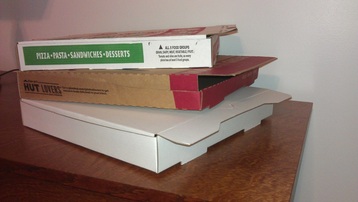 A collection of boxes from local shops led to some curiosity. I was trying to use an example with pizza box design in our polynomials unit, but needed to cater to (yes, pun intended) the visual learners in the room. So, off I went to play the teacher card and ask for an unused medium box from several places to see if one store held an advantage over another size-wise. Of course, the shops obliged, so I should give a shout-out here to Pizza Hut, Gambino's Pizza, and Wheat State Pizza. I hope to time this to influence a bit of Super Bowl ordering hysteria, but a math teacher's endorsement is probably not big on their respective radars, let's face it. Focus your attention, though, on the center box in my photo. It seems to have a chunk missing out of that front edge, no? That box belongs to Pizza Hut, called their new Eco Box, and had previously included some text on the box boasting it would "keep tons of cardboard out of landfills annually." Of course, the math teacher in me wanted to quantify just how many tons of cardboard they were talking about.
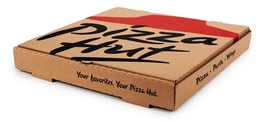 Old Pizza Hut box. Click image for source link. I also must disclose, a significant amount of my information and some graphics came from a blog post on Chainalytics' website written by Rich Lindgren as well as a post of the same article on Packaging Matters' blog. They begin by taking note of Pizza Hut's previous box design. Nothing out-of-the-ordinary. Just a standard, rigid, corrugated cardboard pizza box. As a math teacher, if you have not unfolded one of these boxes to show how the volume of the box can be shown from its flat template, I highly recommend it for the sake of the visual learners in your class. Label the height of the box as " ( x )" and the subsequent size of the width could be described as (16 - 2x) with respect to the overall width of 16 inches for the template less x inches for the left and right edges, and the length as (32 - 3x) / 2 to account for the front edge folding over itself and the back edge of the box. Showing students that the volume of the box, V = x (16 - 2x) ((32 - 3x)/2) , has many values has led to interesting conversation for me but mainly drives at the inquiry as to why the maximum volume is NOT utilized, which lends to the idea of perhaps rephrasing the function so that we can more easily state that the base must remain a square. If you have suggestions on this, please include them in the comments below.
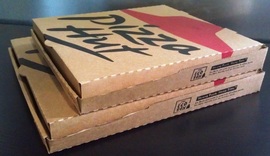 The Pizza Hut Eco Box. Click for image source link. Anyhow, enter the Pizza Hut Eco Box. Again, nothing out-of-the-ordinary at first glance. But that front edge is different than your average pizza box, actually it is half the height of the front edge but does not hamper the box's performance at all.
Earlier versions of this box claimed they would "keep tons of cardboard out of landfills annually." My skepticism got the better of me, so here I am writing a blog post about it.
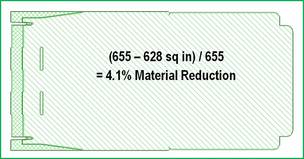 Box flat comparison. Click image for source link. Turns out, that little missing strip of cardboard really has a big impact when extended upon Pizza Hut's annual sales projections. Packaging Matters' blog post saved me some time in calculating, and visualizing, those figures. Okay, I'm buying into the "tons of cardboard" savings claim now, because I realize Pizza Hut is a pretty big player in the world of pizza. Plus, this visualization also gives me yet another example in calculating percent change, which are fun to accumulate.
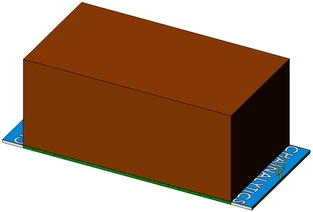 Visual of annual cardboard conserved. Click for image source. Quoted straight from the Packaging Matters blog post: Now 4% does not seem like a huge number, but at Pizza Hut USA volumes (estimated 675,000 boxes per day), that is an annual reduction of over 46 million square feet of corrugated board. To put that in perspective, that would be an NFL Football Field w/o end zones over 128 feet high.With an estimated half-cent savings per box, it is not likely to come with a price drop on their menu, but the cost savings the company will incur is likely to be in the millions of dollars. And while only shaving off about two inches of space these flat boxes will occupy on a stockroom shelf is not a substantial victory in clearing kitchen space, it is indeed a case of "less is more."
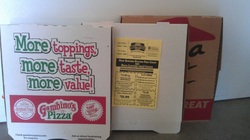 Again, I want to thank local pizza shops Pizza Hut, Gambino's Pizza, and Wheat State Pizza, for allowing me to play the teacher card and get a "free" box from them. I'm sure they are going to get some business out of me in the future. And while I'm at it, I'd be remiss if I didn't tell you that their stuff is worth a try, if you are in the are. Also, I tried to time this post on Super Bowl Sunday, the capstone of the week with the most pizza purchasing power annually (an anticipated 4 million pizzas purchased in 2012, not including homemade pies or frozen pies). I'm not trying to soak up any spotlight, but figured it was appropriate timing for this topic. And just like the rest of you, I'm rooting for Coach Harbaugh's team. --Keltner--
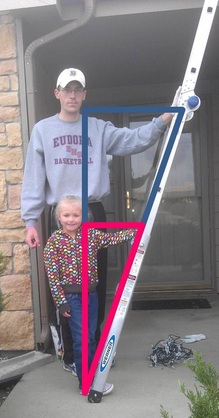 I am not of Griswold heritage, thank you. Yup, I'm "that guy" in the neighborhood who puts up Christmas lights on the house the weekend after Halloween. Contrary to popular belief, though, I do it out of planning for inclement weather conditions that seem to come soon after November begins. While my daughters appreciate seeing our lights on, they also enjoy helping out with putting them on the house. Hence, the picture at left of my second daughter and I, properly footing a ladder. That's a term I learned through my firefighter classes, and also learned the proper angle for ground ladders of this type. The rule of thumb for proper ladder angle says: - If you can stand at the base of the ladder and reach out to the rung directly in front of your shoulder, the ladder is at a proper angle if you touch somewhere on the palm of your hand (to allow a little bit of room for error).
- If the ladder is positioned somewhere on your forearm, it is too steep and poses a safety hazard.
- If the ladder is so shallow that your fingers cannot reach it, the ladder will flex under the weight of the user and increase the potential for collapse of gutters or other objects at the other end of the ladder.
So I made sure to superimpose figures on the photo of me and wee-me to display the similar triangles that occur, but also to show the relationship of slope and how it relates to three collinear points along the ladder. [NOTE: The fact that my arm and duaghter's arm are not fully extended is due to the fact we stood PRECISELY at the base of the ladder instead of lining up our toes with the base. This was because I wanted to illustrate the slope more directly and not have to account for shoe size, although we both wear size 11 right now, just different categories.]
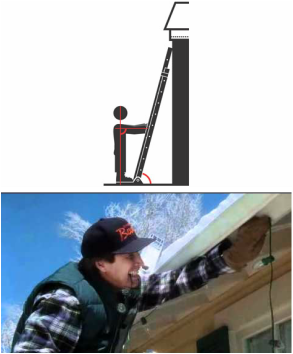 Proper Ladder Angle should be at a 4-to-1 ratio (slope). The diagram at left also illustrates proper ladder angle, but does not include the ladder extending above the surface it is leaning on. The other feature I must point out is the user's feet are AT the ladder's feet, not lined up at the ankle's as my daughter's and my ankles were in the photo above.
While I'm not dwelling on a whole lot of math within this post, there are a lot of different directions a teacher can go with this: similar triangles and slope are just a sample.
Moreover, I would hope you get a little grin on your face as the holiday season arrives in the coming days, weeks, and month(s).
We definitely have a hefty glow at our house now. And yes, our lights did work the first time I plugged them in.
--Keltner--
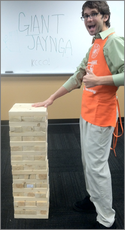 As the summer wound down, I found myself frequenting home improvement stores to cross of those last few items on my to-do list. In that wandering, I came across a Giant Jenga topic on a Home Depot Community blog by employees/associates. I figured this would be a great way to tie-in at the beginning of the school year to talk about traits of shapes (in this case squares, so that the Jenga tower has no overlapping from one level to the next). Particularly, I wanted them to address the trait of the assembly that the length of each board was supposed to be the width multiplied by the number of boards stacked across the assembly--in this case, 3 x 5.5" since we went three boards across and each measured 5.5" wide. I was able to toss the idea at the woodworking teacher, who was going to be biding his time in class until students had passed their safety quizzes so they could safely operate the machinery in their shop. He agreed that a straightforward, repetitive project like this one would allow his students to use multiple machines (miter saw, table saw, and planer for example). Before embarking on the project, I made sure to set the scene with my students and pique their interest in creating their own Giant Jenga. They insisted we Google it to see if someone else had already come up with the idea before them. A sweet collection of games came up, but mostly photos, aside from the Home Depot article I'd mentioned above. They noticed it included measurements (i.e. the answer, they thought). I agree with Dan Meyer here: questions like these are most effective when they are un-Google-able.
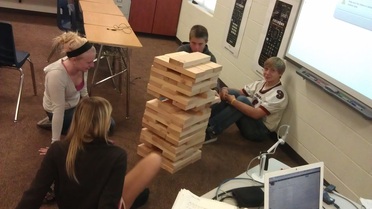 Students try out our Giant Genga game as a reward for their efforts. I insisted we go bigger than the Home Depot site had done; we should use 2" x 6" boards instead. The task in class that day was for them to help me make out my shopping list. Some prompts we had to answer: - Why did the Home Depot site mention each board being cut to 10.5" long?
- Would that same length apply when using 2" x 6" boards?
- Could we just buy the longest boards available, or would 8-foot, 10-foot, or 12-foot boards help minimize waste?
- How many, and which length, should I purchase? (When I was at the store, I also discovered the unit rate for these boards differed somewhat; namely that the shorter boards were the cheapest for foot-length. I anticipate revisiting this observation in a later lesson.)
The final product is pictured here. Although it is heavy and not "broken in yet" where the pieces slide easily in and out of their slots, students have enjoyed playing it in the couple of opportunities they have had. The other students from the woodworking class have come by to see the final product in action, since they only saw the raw materials and had not seen the final product in action. I saw recently where Andrew Stadel had posted about an "experienced" Rubik's cube he held onto and a curious student managed to master quickly. While I have a growing collection of Rubik's cubes and similar puzzles (as seen on the banner for this site, atop the shelves in my classroom with Hoberman spheres and other math-y relics), I hope this Giant Jenga game at least makes an impact on these students since they are the ones who came up with the recipe--or the shopping list, I suppose. --Keltner--
|










 RSS Feed
RSS Feed